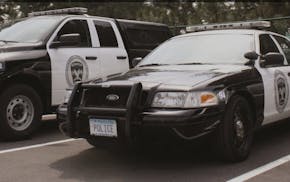Downtown Minneapolis is riddled with vacancies, and the doldrums of its main drag, Nicollet Mall, have been debated since long before the pandemic.
The latest debate: buses.
For Minneapolis Mayor Jacob Frey, whose involvement in years of workgroup meetings begat several plans for enlivening downtown, a key step is to take buses off Minneapolis' busiest transit corridor in hopes of creating more vibrancy for bikes and pedestrians.
"My job is to provide a vision for the future of the city, and specifically the future of downtown," Frey said. "If you want something different, you've got to try something different."
Guided by the Downtown Action Plan, city staff aim to move buses off Nicollet Mall by the end of 2026. But plenty remains to be decided, including: Where will the buses relocate; how much will it cost; and what will City Council members have a say over?
The changes will affect thousands of people who ride Nicollet Mall's five bus lines, racking up an estimated 12,000 rides each day. And opposition is bubbling.
A city survey found the majority of respondents were willing to entertain at least one of three alternative routes, but 33% — the largest block, including the heaviest bus users — wanted no change.
The Minneapolis Pedestrian Advisory Committee has, perhaps ironically, recommended against full pedestrianization for the sake of riders who are disabled, elderly and third-shift workers.
And earlier this month, a group requested a court order to halt the plan until the city conducts an environmental analysis and American with Disabilities Act impact assessment.
James Velek, a wheelchair user who chose to live at Nicollet and 15th because of its proximity to the bus, takes it daily to work at the Guthrie Theater, shop at Target and bank in the IDS Tower. If the buses moved to Marquette and 2nd or 3rd, he'd have to "zig-zag" and "backtrack" through less accessible side streets to reach stops on avenues that feel desolate and dicey at night, he said.
"It isn't change that I'm afraid of, it's change for the worse," said Velek. "Our world is changing so fast, and it seems like I don't have a say in anything."
Opportunities to improve transit
Buses have been integrated into Nicollet Mall for the better part of a century. But they don't move as quickly as they could because there aren't enough lanes for passing when one takes too long to load passengers. When buses pile up, they pump their exhaust on bicyclists and restaurant patios.
Minneapolis Public Works Director Tim Sexton says moving the buses to other streets, where they could get around each other, would reduce travel time.
But there would be significant costs associated with adding lighting and shelters, fixing sidewalks and other things not yet identified. The city hasn't proposed a budget yet. Staff aim to have an estimate later this spring, Sexton said.
Also unclear is what formal role the City Council will get to have in deciding bus routes. At a minimum, council would vote on allocating funds. But at their last climate committee meeting, some council members expressed frustration about having little control over plans upsetting their constituents.
Bus rider David Petersen doesn't believe any of the alternative options are tenable for him, and he feels apprehensive about having to navigate the many cracked sidewalks of the streets beyond Nicollet in his wheelchair.
"It's going to hurt," he said. "But I feel like [the decision] is pretty much done and over with."
A coalition of social justice and environmental organizations including Bicycle Alliance, Hennepin for People, ISAIAH and Sierra Club have also criticized what they see as a predetermined outcome of the city's process.
"It is not typical for a study to presume results in advance. Doing so is what produces flawed alternatives," according to the group's letter, which does not take a position on whether buses should ultimately leave Nicollet Mall.
Former Mayor R.T. Rybak, now president of the Minneapolis Foundation, said it had always been his desire to divert buses from Nicollet.
Nearly 20 years ago, after the Interstate 35W bridge collapse, the Metropolitan Council received $133 million from the federal government to upgrade regional transit. Much of it was spent on converting Marquette and 2nd to transit corridors, and Rybak had high hopes of moving Nicollet Mall's buses there following Nicollet's latest reconstruction in 2017, he recalled.
Metro Transit determined that Marquette and 2nd lacked the capacity at the time, he said. But express bus ridership has completely changed post-pandemic.
"I believe it's a colossal mistake to not follow through on the plan," Rybak said, "so Nicollet could be a people-oriented street that would create the sort of place that someone wanted to come to the office more because they could take a sunny walk at lunch, and come at evening, because they could go to a sidewalk cafe that wasn't next to buses."
(The Minneapolis Foundation administers donations to the Minnesota Star Tribune's charitable fund.)
The larger puzzle of downtown
One criticism of shifting buses from the residential neighborhoods on Nicollet's south end to the streets that make up downtown's corporate core is that the latter have even fewer ground-floor businesses and eyes on the street — especially at night.
Erik Hansen, the city's director of Community Planning and Economic Development, said he's hopeful that as an "ancillary benefit" to getting more visitors down to Nicollet Mall for experiences like street festivals and farmers markets, more businesses will open on the surrounding streets, including Marquette and 2nd, as part of the "regional mall effect."
The reason there are still more businesses on Nicollet Mall than elsewhere is because zoning codes mandate that commercial facades along Nicollet Mall contain transparent windows at the street level to create visual interest and a sense of security, Hansen said.
But code enforcement is complaint-based. In practice, many shops and restaurants along Nicollet Mall have heavily tinted, shuttered and blocked windows.
Metro Transit bus driver Steven Glasford, who started the injunction petition, says buses bring a diversity of people to Nicollet Mall. He's skeptical that pushing out local bus riders — a group of people who consistently came downtown even when the suburban commuters on Marquette and 2nd stopped during the pandemic and Target moved its headquarters — would increase foot activity in the long run.
"The real cause for a reduction in life and activity on Nicollet Mall are the giant spaces that replaced small businesses," Glasford said.
Chopping up the hard-to-rent commercial bulk along Nicollet is another perennial idea with a lot of support, including Frey's. But it's something building owners need to do voluntarily.
Similarly, they'd have to commit to planting the greenery that got left out of Nicollet Mall's last lackluster renovation, producing everyday family events in between the blockbuster festivals, and all the other parts of the formula for manifesting foot traffic on Nicollet Mall after the buses are gone.
That would be costly, likely requiring a combination of public and private funding, said Adam Duininck, president of the Downtown Council.
"But when you think about the street itself, you have some really amazing tenants, from the Four Seasons to Hennepin County in the library, to Fortune 500 companies, U.S. Bank, Target and Xcel Energy," said Duininck. "It's a street unlike any other street in our entire state and so to me, it has a statewide and a regionwide significance. So thinking about who pays for that sort of thing, I think it's worth opening the door to well, if it's statewide significance, and we're trying to draw people from the state and the Upper Midwest, then maybe there's a funding source that matches the need as well."
Metro Transit is working with the city to redefine downtown transit, but the city has the authority, on its own, to determine if buses operate on Nicollet Mall, said Metro Transit spokesperson Drew Kerr.

Four arrested, no one injured in fighting and shooting following Burnsville High School graduation

One man dead in shooting Friday outside Northtown Mall in Blaine

University of Minnesota is putting its golf course up for sale
Supreme Court allows DOGE team to access Social Security systems with data on millions of Americans

